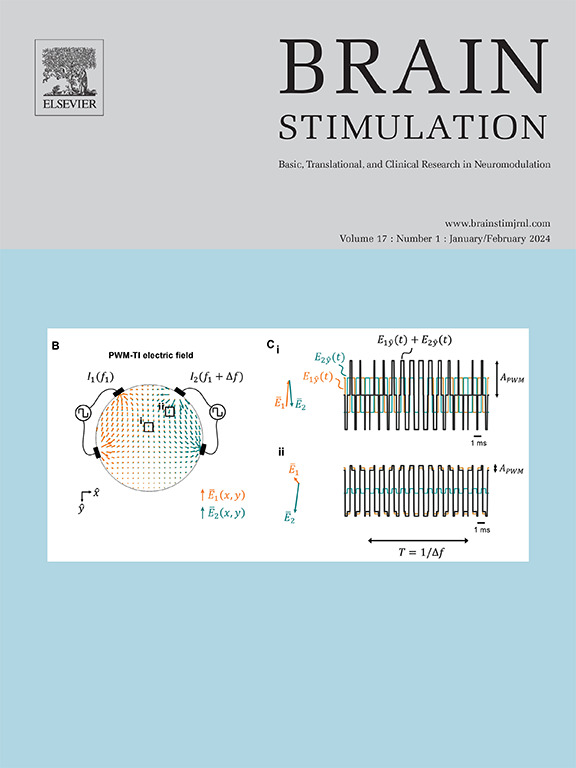重复经颅磁刺激对颈肌张力障碍病变网络的脑代谢反应
IF 8.4
1区 医学
Q1 CLINICAL NEUROLOGY
引用次数: 0
摘要
背景一项先前的研究根据颈肌张力障碍(CD)的因果关系确定了一个脑网络。该网络在特发性颈性肌张力障碍中显示异常,并与介导脑深部刺激治疗反应的连接相一致,这表明该网络具有跨病因的普适性和治疗相关性。该网络的主要节点位于小脑深层结构和躯体感觉皮层(S1),后者可通过非侵入性脑刺激轻松到达。目标通过刺激 S1 评估目标参与情况,并测试 CD 患者和健康对照组的大脑对重复经颅磁刺激的急性代谢反应。方法13 名 CD 患者和 14 名对照组患者接受一次连续θ脉冲(cTBS)和假性右 S1 刺激。结果cTBS增加了CD患者刺激部位的新陈代谢(P = 0.03),但没有增加对照组的新陈代谢(P = 0.15;组间差异P = 0.01)。在皮层下区域,cTBS 仅增加了 CD 脑干的新陈代谢(PFDR = 0.04)。远程激活与 CD 患者肌张力障碍的严重程度和感觉伎俩现象的疗效呈正相关。结论我们的研究结果为 CD 患者感觉系统功能异常提供了进一步的证据,并表明单次 S1 cTBS 足以诱导脑葡萄糖代谢发生可测量的变化。这些研究结果支持靶点参与,促使对 CD 患者的 S1 进行 cTBS 治疗试验。本文章由计算机程序翻译,如有差异,请以英文原文为准。
Brain metabolic response to repetitive transcranial magnetic stimulation to lesion network in cervical dystonia
Background
A previous study identified a brain network underlying cervical dystonia (CD) based on causal brain lesions. This network was shown to be abnormal in idiopathic CD and aligned with connections mediating treatment response to deep brain stimulation, suggesting generalizability across etiologies and relevance for treatment. The main nodes of this network were located in the deep cerebellar structures and somatosensory cortex (S1), the latter of which can be easily reached via non-invasive brain stimulation. To date, there are no studies testing brain stimulation to networks identified using lesion network mapping.
Objectives
To assess target engagement by stimulating the S1 and testing the brain's acute metabolic response to repetitive transcranial magnetic stimulation in CD patients and healthy controls.
Methods
Thirteen CD patients and 14 controls received a single session of continuous theta burst (cTBS) and sham to the right S1. Changes in regional brain glucose metabolism were measured using [18F]FDG-PET.
Results
cTBS increased metabolism at the stimulation site in CD (P = 0.03) but not in controls (P = 0.15; group difference P = 0.01). In subcortical regions, cTBS increased metabolism in the brainstem in CD only (PFDR = 0.04). The remote activation was positively associated with dystonia severity and efficacy of sensory trick phenomenon in CD patients.
Conclusions
Our results provide further evidence of abnormal sensory system function in CD and show that a single session of S1 cTBS is sufficient to induce measurable changes in brain glucose metabolism. These findings support target engagement, motivating therapeutic trials of cTBS to the S1 in CD.
求助全文
通过发布文献求助,成功后即可免费获取论文全文。
去求助
来源期刊

Brain Stimulation
医学-临床神经学
CiteScore
13.10
自引率
9.10%
发文量
256
审稿时长
72 days
期刊介绍:
Brain Stimulation publishes on the entire field of brain stimulation, including noninvasive and invasive techniques and technologies that alter brain function through the use of electrical, magnetic, radiowave, or focally targeted pharmacologic stimulation.
Brain Stimulation aims to be the premier journal for publication of original research in the field of neuromodulation. The journal includes: a) Original articles; b) Short Communications; c) Invited and original reviews; d) Technology and methodological perspectives (reviews of new devices, description of new methods, etc.); and e) Letters to the Editor. Special issues of the journal will be considered based on scientific merit.
 求助内容:
求助内容: 应助结果提醒方式:
应助结果提醒方式:


